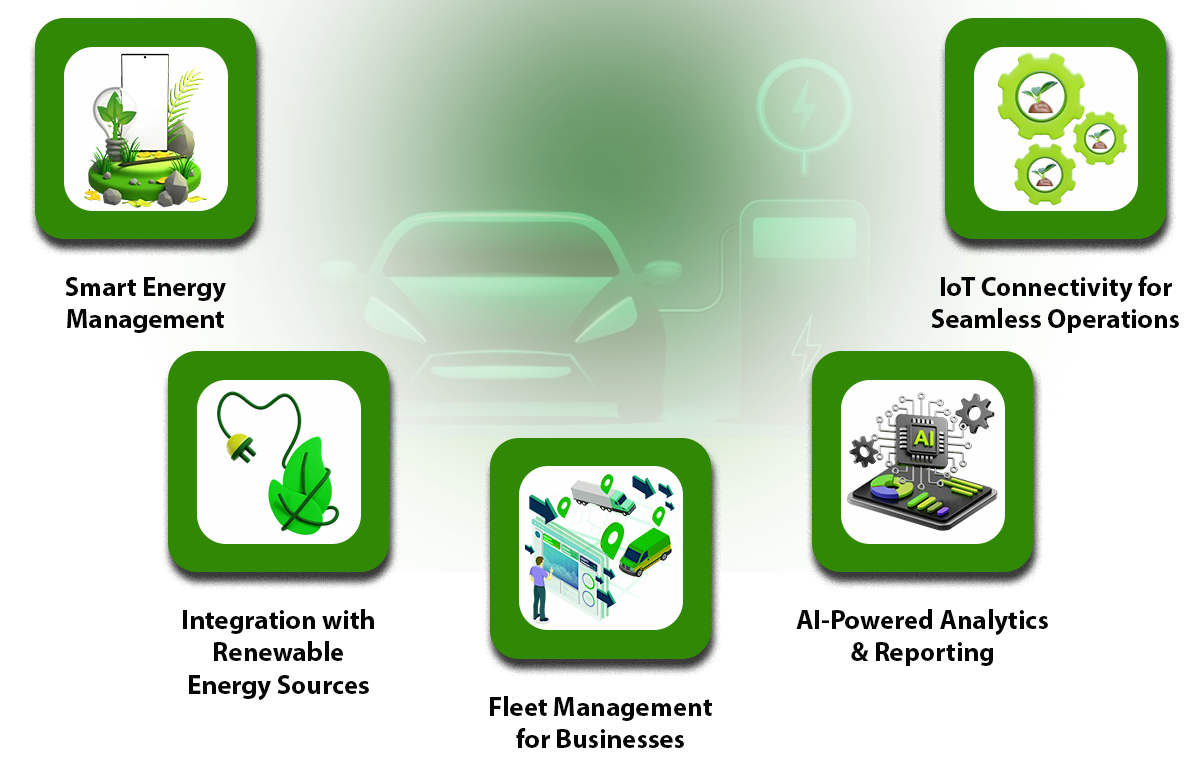With increasing concerns about climate change and a push for cleaner energy, more people are choosing EVs over traditional fuel-powered cars. In 2023, global EV sales reached over 14 million, accounting for nearly 18% of all new car sales, up from just 4% in 2020. EV sales surged by 155% in 2023, reflecting a growing shift towards sustainable transportation. However, for this growth to continue, an expansive and reliable network of EV charging stations is critical. Without accessible charging infrastructure, potential buyers may hesitate to transition to EVs.
EV charging management software allows operators to monitor and manage charging stations, optimize energy usage, and ensure smooth operations. For EV owners, these platforms provide real-time information about station availability, pricing, and charging speeds, enhancing convenience and reliability. As the number of EVs increases, smart management solutions also help prevent grid overload by balancing energy demand during peak hours. So, if you want to develop EV charging management software, it’s a great opportunity. Let’s dig into how much it costs to build an EV charging management software.
EV charging management software allows operators to monitor and manage charging stations, optimize energy usage, and ensure smooth operations. For EV owners, these platforms provide real-time information about station availability, pricing, and charging speeds, enhancing convenience and reliability. As the number of EVs increases, smart management solutions also help prevent grid overload by balancing energy demand during peak hours. So, if you want to develop EV charging management software, it’s a great opportunity. Let’s dig into how much it costs to build an EV charging management software.
What is EV Charging Management Software?
EV charging management software is a digital platform designed to streamline the operation and management of electric vehicle (EV) charging stations. It ensures that charging stations work efficiently, provides a smooth user experience for EV drivers, and supports integrating charging networks with energy systems. As the EV market grows, such software has become essential for scaling charging infrastructure while maintaining reliability.
What Does EV Charging Management Software Do?
EV charging management software performs several key functions:
Some well-known EV charging management software examples include ChargePoint, EV Connect, Greenlots, and Electrify America’s network software. These platforms are widely used for managing public, workplace, and residential charging stations, offering features like remote monitoring, dynamic pricing, and energy optimization.

What Does EV Charging Management Software Do?
EV charging management software performs several key functions:
- Managing and Monitoring EV Chargers: Operators can oversee multiple charging stations from a single platform. They can monitor charger performance, identify technical issues, and schedule maintenance to minimize downtime.
- Handling Payments and Billing: The software simplifies the payment process by offering multiple payment options, such as credit cards, digital wallets, or subscription plans. It also manages billing and provides detailed transaction records for operators and users.
- Real-Time Status Updates and Analytics: Users can check the availability of charging stations, see estimated wait times, and track charging progress in real-time. Operators can use analytics to understand usage patterns, optimize station placement, and forecast future demand.
- Integration with Energy Management Systems: It helps integrate EV chargers with renewable energy sources or smart grids, balancing energy usage and preventing overload during peak hours. This also supports the use of cleaner energy for charging.
Some well-known EV charging management software examples include ChargePoint, EV Connect, Greenlots, and Electrify America’s network software. These platforms are widely used for managing public, workplace, and residential charging stations, offering features like remote monitoring, dynamic pricing, and energy optimization.

Key Features of EV Charging Management Software
EV charging management software has various features catering to basic and advanced needs. These features ensure smooth operations for charging station operators and a seamless experience for EV users.
Basic Features
Basic Features
- User Registration and Profile Management: This allows users to create accounts, store payment details, and manage their preferences. It also helps operators track user activity and offer personalized services.
- Charger Status Monitoring: Real-time updates on charger availability, performance, and usage are critical for reducing waiting times and ensuring efficient operations.
- Payment and Billing System: This feature includes multiple payment options (credit cards, digital wallets, or subscriptions) and automated billing systems. Transparent payment tracking builds user trust.
- Real-Time Notifications: Alerts about charger availability, session completion, or issues provide a convenient user experience.
- Smart Energy Management: Advanced systems optimize energy usage by balancing load during peak hours and integrating with smart grids. This reduces energy costs and supports efficient operations.
- Integration with Renewable Energy Sources: Charging stations connected to solar or wind energy systems can reduce carbon footprints. The software manages these connections, ensuring efficient energy usage.
- Fleet Management for Businesses: Designed for companies with electric fleets, this feature helps track vehicle charging schedules, optimize routes, and monitor fleet performance.
- AI-Powered Analytics and Reporting: Advanced analytics use AI to identify trends, predict demand, and provide actionable insights for station operators. This helps in decision-making and scaling infrastructure effectively.
- IoT Connectivity for Seamless Operations: IoT-enabled software connects hardware components, allowing real-time data exchange, remote diagnostics, and predictive maintenance.

How Features Influence Development Costs
The cost of developing EV charging management software depends on the complexity and number of features included:
- Basic Features: Adding these are generally more affordable as they involve standard functionalities. Depending on the software scale, costs typically range from $50,000 to $100,000.
- Advanced Features: These require integrating smart grids, IoT devices, and AI algorithms, significantly increasing development costs. A comprehensive solution can cost between $200,000 and $500,000.
Factors Affecting the Cost of EV Charging Management Software Development
Developing EV charging management software involves several factors that influence the overall cost. Below is a detailed look at the key elements that determine the expense of creating such software.
1. Development Approach: Custom-Built vs. Off-the-Shelf Solutions
3. Feature Complexity
4. Third-Party Integrations
1. Development Approach: Custom-Built vs. Off-the-Shelf Solutions
- Custom-Built Solutions: These are tailored to specific needs and provide full control over features and scalability. However, they are more expensive, ranging from $100,000 to $500,000 depending on complexity.
- Off-the-Shelf Solutions: These are pre-built platforms with limited customization. They are quicker and cheaper, often costing $20,000 to $50,000, but may lack flexibility and advanced features.
- Developing for web-only platforms is less costly but limits accessibility.
- Mobile compatibility (iOS and Android) increases costs due to the need for separate development for each platform. A cross-platform app using tools like Flutter may reduce expenses, but performance might be slightly compromised.
- Depending on the scale, multi-platform software costs range from $150,000 to $400,000.
3. Feature Complexity
- Basic Functionalities: User registration, charger monitoring, and payment systems are standard and cost less to implement.
- Advanced Features: AI-powered analytics, IoT connectivity, and smart energy management require more development time and expertise. Advanced features can increase costs by 50-100%.
4. Third-Party Integrations
- Integrations with payment gateways (like PayPal or Stripe) and energy management systems add functionality but increase development costs.
- For example, integrating renewable energy systems or fleet management tools can add $10,000 to $50,000 depending on complexity.
- Simple UI: A minimalistic design is cost-effective, providing basic user interactions.
- Highly Interactive UX: Advanced design elements like real-time animations, intuitive navigation, and custom graphics enhance user experience but increase costs by 20-40%.
- Local Developers: Hiring developers in countries like the US or UK can cost $150-$200 per hour, resulting in higher development costs.
- Offshore Developers: Teams in regions like India or Eastern Europe charge $25-$75 per hour, offering more affordable options without compromising quality.
- Ongoing maintenance, including software updates, security patches, and scalability enhancements, is a recurring cost.
- Maintenance typically costs 15-20% of the initial development cost annually. For example, a $200,000 project could require $30,000-$40,000 per year for upkeep.
Cost Breakdown for Building EV Charging Management Software
Developing EV charging management software involves multiple phases, each contributing to the overall cost. Below is a detailed breakdown of the key development phases and estimated costs based on feature complexity and team size.
1. Research and Discovery Phase
This phase involves understanding user needs, analyzing market trends, and creating a detailed project plan. It includes competitor analysis, identifying technical requirements, and outlining features.
2. UI/UX Design
The design phase focuses on creating wireframes, prototypes, and user interfaces. A well-designed interface ensures a smooth user experience and clear navigation.
This is the most critical and resource-intensive phase, involving the development of the user interface (frontend) and core functionalities (backend).
This phase ensures that the software is bug-free and runs smoothly across all devices. It includes functional, performance, and security testing.
Deployment involves launching the software on app stores, cloud servers, or on-premise systems. Maintenance includes regular updates, bug fixes, and scalability improvements.
1. Research and Discovery Phase
This phase involves understanding user needs, analyzing market trends, and creating a detailed project plan. It includes competitor analysis, identifying technical requirements, and outlining features.
- Duration: 2-4 weeks.
- Cost: $5,000 to $15,000.
- Factors Influencing Cost: The extent of research and the involvement of industry experts.
2. UI/UX Design
The design phase focuses on creating wireframes, prototypes, and user interfaces. A well-designed interface ensures a smooth user experience and clear navigation.
- Duration: 4-6 weeks.
- Cost: $10,000 to $30,000.
- Factors Influencing Cost:
- Simple, minimalistic designs cost less.
- Interactive and visually rich designs with custom animations cost more.
This is the most critical and resource-intensive phase, involving the development of the user interface (frontend) and core functionalities (backend).
- Frontend Development: Focuses on creating responsive designs for web and mobile platforms.
- Backend Development: Includes building the server, database, and integrations for features like payment gateways, charger monitoring, and analytics.
- Duration: 12-20 weeks.
- Cost: $50,000 to $200,000.
- Factors Influencing Cost:
- Number of platforms (web, iOS, Android).
- Complexity of features like AI-powered analytics, IoT connectivity, and renewable energy integration.
This phase ensures that the software is bug-free and runs smoothly across all devices. It includes functional, performance, and security testing.
- Duration: 3-5 weeks.
- Cost: $10,000 to $20,000.
- Factors Influencing Cost:
- The number of platforms tested.
- Complexity of features and integrations.
Deployment involves launching the software on app stores, cloud servers, or on-premise systems. Maintenance includes regular updates, bug fixes, and scalability improvements.
- Deployment Cost: $5,000 to $10,000 (one-time).
- Maintenance Cost: 15-20% of the initial development cost annually.
- Factors Influencing Cost:
- Frequency of updates and enhancements.
- The scale of infrastructure upgrades.
Estimated Costs Based on Feature Sets and Team Size
Basic Version:
- Features: User registration, charger monitoring, payment system, basic analytics.
- Team: 4-6 members (developers, designers, testers).
- Total Cost: $50,000 to $100,000.
- Features: AI analytics, IoT connectivity, fleet management, smart energy integration.
- Team: 8-12 members (specialists in AI, IoT, energy systems).
- Total Cost: $150,000 to $500,000.
Steps to Build EV Charging Management Software
Building EV charging management software requires careful planning and execution. Below is a step-by-step guide to creating software that meets user needs and ensures reliable operations.
1. Understanding Your Target Audience and Market
Start by identifying the users who will interact with the software. These could include EV owners, charging station operators, fleet managers, and energy providers. Research their needs, pain points, and expectations to shape the software's functionality.
Define the features your software will include. Start with essential functionalities and then consider adding advanced capabilities for a competitive edge.
Select the technologies and tools needed for development. Your tech stack will depend on the platforms (web, mobile) and the complexity of features.
4. Partnering with an Experienced Development Team
Collaborate with a skilled development team that has expertise in EV-related software and emerging technologies like AI and IoT.
Testing ensures that your software is reliable and performs well under various conditions. Deployment involves making the software available to users, and scaling prepares it for future growth.
1. Understanding Your Target Audience and Market
Start by identifying the users who will interact with the software. These could include EV owners, charging station operators, fleet managers, and energy providers. Research their needs, pain points, and expectations to shape the software's functionality.
- Market Research: Analyze current EV adoption rates and charging station availability in your target regions. For instance, global EV sales grew to 14 million in 2023, highlighting a growing demand for charging infrastructure.
- User Needs: Understand what users prioritize, such as real-time charger availability, ease of payment, and support for renewable energy sources.
Define the features your software will include. Start with essential functionalities and then consider adding advanced capabilities for a competitive edge.
- Essential Features: User registration, charger monitoring, payment systems, and real-time notifications.
- Advanced Features: AI-powered analytics, IoT connectivity, smart energy management, and integration with renewable energy systems.
- Prioritization: Begin with a Minimum Viable Product (MVP) that includes core features, then expand based on user feedback.
Select the technologies and tools needed for development. Your tech stack will depend on the platforms (web, mobile) and the complexity of features.
- Frontend: React.js, Angular, or Flutter for responsive user interfaces.
- Backend: Node.js, Python, or Java for robust server-side operations.
- Database: MySQL or MongoDB for data storage.
- Integrations: APIs for payment gateways, IoT devices, and energy management systems.
- Cloud Services: AWS or Google Cloud for scalability and secure hosting.
4. Partnering with an Experienced Development Team
Collaborate with a skilled development team that has expertise in EV-related software and emerging technologies like AI and IoT.
- Team Composition: A typical team includes project managers, UI/UX designers, frontend and backend developers, QA testers, and system architects.
- Expertise: Look for a team familiar with EV standards, renewable energy integration, and smart grid compatibility.
- Cost Considerations: Hiring offshore teams from regions like India or Eastern Europe can reduce costs while maintaining quality.
Testing ensures that your software is reliable and performs well under various conditions. Deployment involves making the software available to users, and scaling prepares it for future growth.
- Testing: Conduct functional, performance, and security tests to identify and fix issues.
- Deployment: Choose the appropriate platform (web, iOS, Android) and ensure compliance with regional regulations, such as GDPR for data security.
- Scaling: Build a scalable architecture to handle increasing users and add new features seamlessly. For instance, a charging network expanding to multiple cities will require enhanced server capacity and robust integrations.
- Start small with an MVP to minimize initial costs and gather user feedback.
- Focus on building scalable and secure software to adapt to the rapidly growing EV market.
- Partnering with an experienced team and choosing the right tech stack are crucial for long-term success.
Conclusion
The cost of building EV charging management software depends on several factors, including the complexity of features, the number of platforms, and the development approach. If you plan to include advanced features like AI-powered analytics, IoT connectivity, or smart energy management, the cost can rise to $150,000–$500,000 or more. Additional expenses for ongoing maintenance, scaling, and integration with renewable energy systems should also be considered to ensure long-term success.
To build reliable and scalable software, working with an experienced development team or company is essential. Experts can guide you in choosing the right technology stack, ensuring seamless integration, and creating user-friendly designs. Investing in professional services not only reduces the risk of delays and technical issues but also ensures that your software meets industry standards and user expectations. Whether you are a startup or an established business, partnering with the right team will help you create a robust solution that supports the growing demand for EV charging infrastructure and positions your business for long-term growth in the EV ecosystem.
To build reliable and scalable software, working with an experienced development team or company is essential. Experts can guide you in choosing the right technology stack, ensuring seamless integration, and creating user-friendly designs. Investing in professional services not only reduces the risk of delays and technical issues but also ensures that your software meets industry standards and user expectations. Whether you are a startup or an established business, partnering with the right team will help you create a robust solution that supports the growing demand for EV charging infrastructure and positions your business for long-term growth in the EV ecosystem.
.jpg?lang=en-US&ext=.jpg)

.webp?lang=en-US&ext=.webp)

.webp?lang=en-US&ext=.webp)

